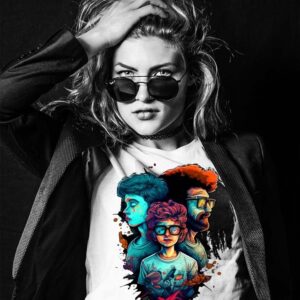





























Graphic printed tees have become a popular choice for individuals looking to express their unique style and personality. American graphic printed tees, particularly, have gained significant popularity due to their wide range of designs and styles. This article will explore the fascinating behind-the-scenes process of creating AI-generated designs for graphic tees. We will delve into the algorithms and techniques used in AI T-shirt design, the benefits of using AI in the creative process, and the future implications of this technology.
The Rise of AI in T-Shirt Design
The fashion industry has witnessed a significant transformation with advancements in artificial intelligence (AI) and machine learning. AI has revolutionized various aspects of the design process, including creating graphic tees. By leveraging AI algorithms, designers can generate unique, eye-catching designs that cater to individual preferences and trends.
AI Algorithms in T-Shirt Design
The algorithms used in AI T-shirt design are complex and intricate, allowing designers to create visually appealing and customized designs. These algorithms analyze vast amounts of data, including color schemes, patterns, and popular design elements. By understanding and interpreting this data, AI algorithms can generate designs that resonate with consumers.
Benefits of AI in T-Shirt Design
The integration of AI in T-shirt design offers numerous benefits. Firstly, AI algorithms can generate a wide variety of designs relatively quickly. This streamlines the design process and provides designers with a vast pool of options. Additionally, AI can adapt to changing trends and consumer preferences, ensuring the designs remain relevant and appealing.
Another significant advantage of AI in T-shirt design is the ability to personalize plans for individual customers. By analyzing customer data and preferences, AI algorithms can create customized designs that cater to specific tastes. This level of personalization enhances the overall shopping experience and increases customer satisfaction.
The Future Implications of AI T-Shirt Design
As AI continues to evolve and improve, the future implications for T-shirt design are vast. AI algorithms have the potential to revolutionize the industry, making it more accessible and inclusive. With advancements in technology, designers can harness AI to create designs that are not only visually appealing but also eco-friendly and sustainable.
The Process of AI T-Shirt Design
Behind the scenes, the process of AI T-shirt design involves several stages, each contributing to creating unique and captivating designs. Let’s explore these stages in detail:
Data Collection and Analysis
The first step in the AI T-shirt design process is data collection and analysis. Designers gather data from various sources, including fashion trends, customer preferences, and popular design elements. This data is then analyzed to identify patterns and insights that can be used to generate innovative designs.
Training the AI Model
Once the data is collected and analyzed, designers train the AI model using machine learning techniques. This involves feeding the AI model with vast design data, allowing it to learn and understand different design elements, color combinations, and patterns. The AI model then uses this knowledge to generate new and unique designs.
Algorithmic Design Generation
After the AI model is trained, it can generate designs based on the learned patterns and preferences. The algorithms used in this stage consider various factors, such as color schemes, design elements, and customer preferences. The AI model combines these factors to create visually appealing and personalized designs.
Human Intervention and Fine-Tuning
Although AI plays a significant role in the design generation process, human intervention is crucial for fine-tuning and adding a creative touch. Designers review and modify the designs generated by the AI model, ensuring that they align with their vision and the brand’s aesthetic. This collaborative process between AI and human designers results in unique and captivating designs.
Prototyping and Production
Once the designs are finalized, they are transformed into physical prototypes. These prototypes visually represent the AI-generated designs, allowing designers to evaluate their feasibility and appeal. After the prototyping stage, the selected plans move into production, printed onto high-quality T-shirts.
The Impact of AI T-Shirt Design
The integration of AI in T-shirt design has significantly impacted the fashion industry. Let’s explore some of the critical implications:
Increased Design Creativity
AI has unleashed a new level of design creativity in the T-shirt industry. By leveraging AI algorithms, designers can experiment with unique patterns, color combinations, and design elements that were previously challenging to explore. This increased creativity leads to a broader variety of designs, catering to diverse consumer preferences.
Enhanced Efficiency and Productivity
Using AI in the T-shirt design process significantly enhances efficiency and productivity. AI algorithms can generate many designs in a fraction of the time it would take a human designer. This allows designers to focus on the creative aspects of the process, refining and perfecting the designs generated by AI.
Personalized Shopping Experience
With AI-generated designs, customers can enjoy a personalized shopping experience like never before. By analyzing customer data and preferences, AI algorithms can create designs that resonate with individual tastes. This level of personalization enhances customer satisfaction and increases brand loyalty.
Sustainability and Waste Reduction
AI T-shirt design also contributes to sustainability efforts within the fashion industry. By leveraging AI to create designs, designers can optimize material usage, reducing waste and minimizing the environmental impact. This shift towards sustainability aligns with the growing consumer demand for eco-friendly and ethical fashion.
FAQs
While AI has significantly impacted the design process, it can only replace human designers partially. Human intervention and creativity are essential for fine-tuning designs and adding a unique touch. AI is a powerful tool that enhances the creative capabilities of human designers.
AI algorithms analyze vast customer data, including browsing history, purchase behavior, and social media activity. By interpreting this data, AI algorithms can gain insights into customer preferences and generate designs that align with individual tastes.
On the contrary, AI T-shirt design expands creativity by providing designers with a vast pool of design possibilities. AI algorithms can explore unique patterns, color combinations, and design elements, allowing designers to push boundaries and create innovative designs.
Yes, AI-generated designs are unique, based on algorithms that analyze vast amounts of data and generate strategies that align with current trends and customer preferences. These designs cannot be replicated precisely, ensuring their uniqueness.
The future of AI in T-shirt design is promising. As AI evolves, we can expect more advanced algorithms that generate highly personalized plans and cater to individual preferences. Additionally, AI can contribute to developing sustainable and eco-friendly fashion practices.
Testimonials
John Emel, Fashion Enthusiast
“I was amazed by the unique designs I found online shopping for graphic tees. The AI-generated designs were unlike anything I had seen before. It’s exciting to see how technology is shaping the fashion industry.”
Jane Solomon, Trendsetter
“As someone who loves to stand out with my fashion choices, AI-generated designs have been a game-changer. Thanks to the creativity and personalization offered by AI algorithms, I can now find T-shirts that perfectly align with my personal style.”
Mike Johnson, Sustainable Shopper
“I appreciate how AI T-shirt design contributes to sustainability efforts. By optimizing material usage and reducing waste, AI is helping to make the fashion industry more eco-friendly. It’s a win-win for both fashion enthusiasts and the planet.”
Behind the Scenes: Understanding the Algorithms of AI T-Shirt Design
| Stage | Description |
| Data Collection and Analysis | Gather data on fashion trends, customer preferences, and popular design elements. Analyze the data to identify patterns and insights for design generation. |
| Training the AI Model | Train the AI model using machine learning techniques. Feed the model with design data to learn and understand different design elements, colors, and patterns. |
| Algorithmic Design Generation | Generate designs based on learned patterns and preferences. Use algorithms to combine design elements, color schemes, and customer preferences for unique designs. |
| Human Intervention | Review and modify AI-generated designs. Fine-tune the plans to align with the vision and aesthetic of human designers. |
| Prototyping and Production | Transform finalized designs into physical prototypes. Evaluate feasibility and appeal. Move selected designs into production for printing on high-quality T-shirts. |
Conclusion
AI has revolutionized the world of T-shirt design, providing designers with the tools to create unique, eye-catching designs. By leveraging AI algorithms, designers can generate various methods, personalize shopping experiences, and contribute to sustainability efforts. While AI complements human creativity, it cannot replace the role of human designers. Together, AI and human designers can push the boundaries of design and create innovative T-shirt collections that resonate with consumers.
So, the next time you browse for graphic tees online, remember the behind-the-scenes work of AI algorithms that have made it possible to find designs that truly express your individuality and style.
For more information and a wide range of AI-generated T-shirt designs, visit oglasee.com